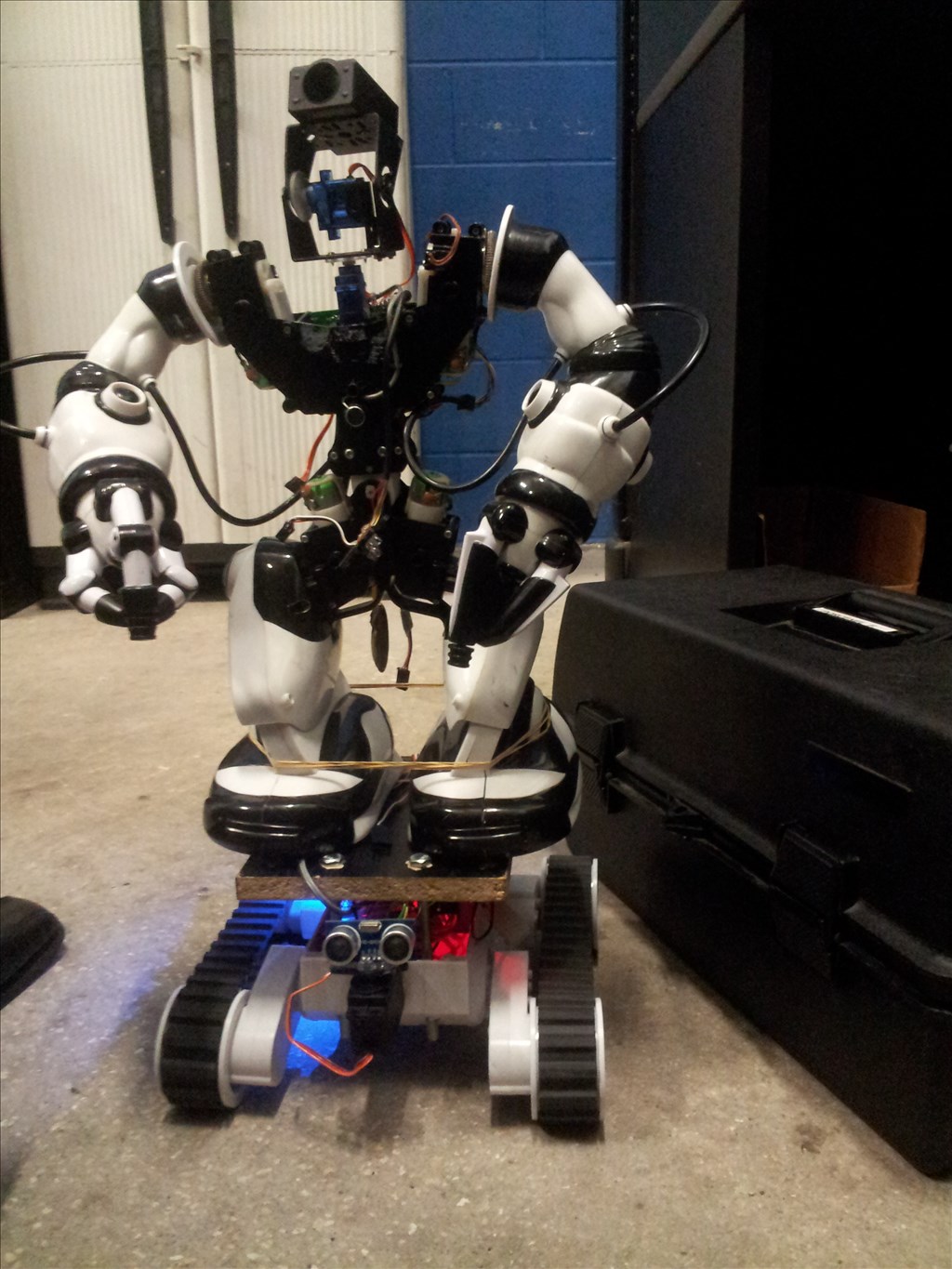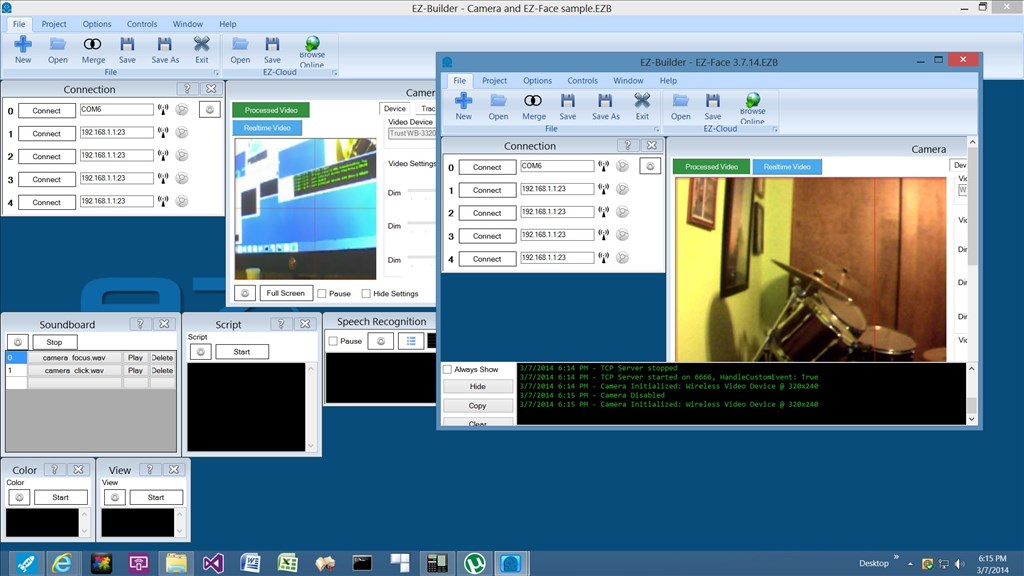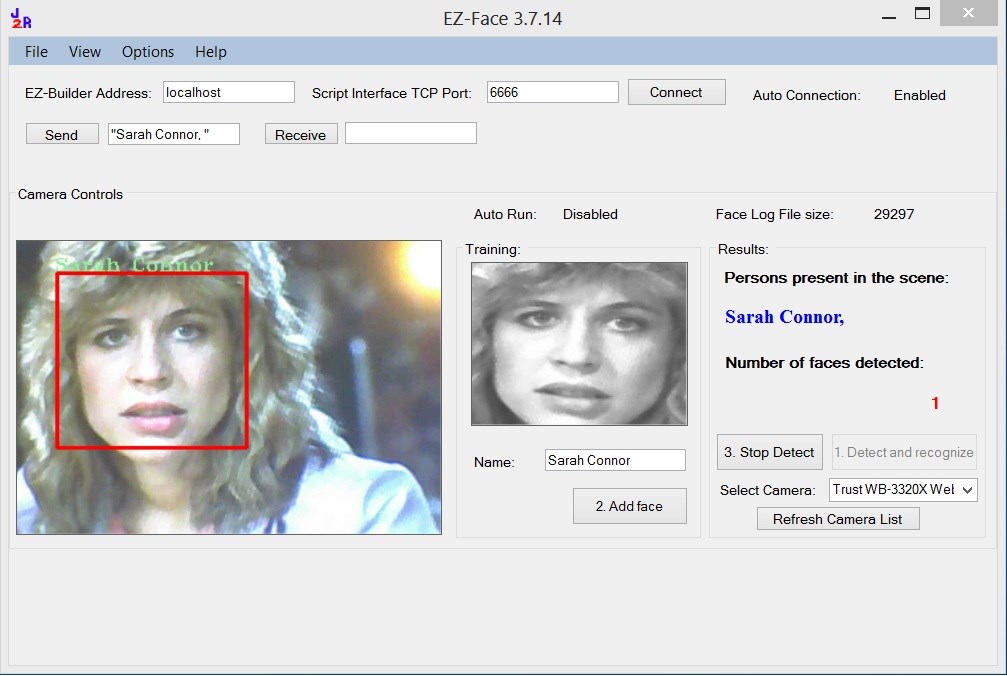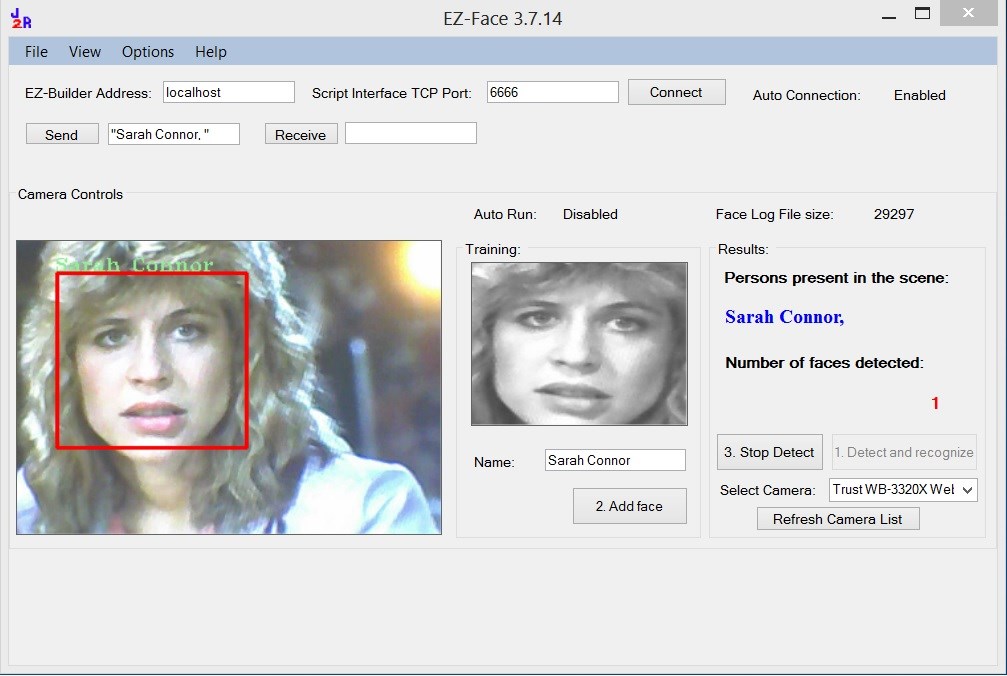EZ-Face is the first in what I plan to develop into a suite of supporting application for ARC and other robotics applications. EZ-Face performs multiple face recognition. It has a interface for training faces and assigning names. When the application sees faces that are recognized the names are displayed and visually you'll see boxes around the faces with the names assigned. If a face is detected but not recognized there will be a display of a box around the face with no name. The more pictures of a face you train, the easier it is for the application to recognize a face.
This is a stand alone application developed in C# under Visual Studio.NET 2013. You should have .NET framework 4.5 and it is for Windows7 and Windows8.x systems.
This project showcase explains the technology behind the application and highlights development milestones.
Technology: Developed in .NET Visual Studio 2013 (you can use express versions with the source code) Designed to work with ARC but could be integrated into other software or robotic systems Is a standalone application Is open source, source code is included Uses emgu cv wrapper for .NET (Open CV)
Resources: (Things I found helpful in creating the application) ARC Telnet interface tutorial (Enable Telnet as the first part Shows, this is used to test communications manually to ARC via TCP/IP): https://synthiam.com/Tutorials/Help.aspx?id=159 If you do not have Telnet installed on your system go to this site: https://technet.microsoft.com/en-us/library/cc771275 ARC SDK Tutorial 52: https://synthiam.com/Community/Questions/4952&page=1 ARC script for listening to the TCP/IP port for variables: https://synthiam.com/Community/Questions/5255
Acknowledgements: DJ Sures, for making EZ-Robot and ARC so robust Rich, for his help with ARC scripting Sergio, for his emgu cv examples
Basic Usage Direction (after download and install): 1.) Open ARC and load the included EZ-Face example 2.) Click on the Script start button (this sets up the communications from the ARC side of things) 3.) Open the EZ-Face application 4.) Refresh your camera list (click the button) 5.) Select your camera (in the drop down list) 6.) Click the "1. Detect and recognize" button 7.) Train at least one face 8.) Change the local address and port number as needed (the local IP address may not be your computer's address - you can enter "localhost" and leave the port set to 6666 unless you changed that setting in ARC) 9.) Click File and select Save User Settings (to store your changes) 10.) Click Connection (this opens the communication line to ARC from the EZ-Face app side 11.) Allow EZ-Face to recognize the face you trained - then with your computer speakers turned on ARC should speak "Hello (the name of the face you trained)" 12.) If the example work - integrate in your EZ-Robot applications as you see fit
Tips: 1.) If after training several faces if you get false recognition of faces (faces recognized with the wrong name) - to correct this you should train the incorrectly recognized faces with the correct name. After a couple of training pictures are stored the accuracy of the face recognition will improve. 2.) Do not train faces with one camera, then switch to another camera for face recognition - recognition accuracy will drop.
Using Two Cameras: What I found worked best was to start ARC, select the camera I wanted and started the camera feed, then I started EZ-Face. If I reverses the process (even though I was selecting a different camera) I would get a black image in ARC.
2.26.14 Update: I still have several improvements I want to make before I upload the first public version of the application.
3.2.14 Update: The first public version is ready for release and is posted at the link below. This version has many user improvements to allow you store many settings, including http and port address, camera device, logging of faces in a text file (up to 1mb of data before the file auto deletes), face variable output to ARC, face training and more.
3.3.14 Update:
I updated the script, version 3.3.14 has the HTTP server panel (which is not used - you don't need to start it) but it does show you your computer's IP address so you can enter it in EZ-Face. Remember to save your settings under the File Menu. I also changed the script so it will no only speak for variable values greater than "" or NULL.
EZ-Face3.3.14.EZB
3.7.14 Update: I updated the EZ-Face application: "localhost" is now the default address, new option for auto connect, functions to receive commands from ARC or other 3rd party application to stop and start the camera feed within EZ-Face. There is also a new ARC project with several new scripts to test out the functions. Please go to my site to download the latest version. You will also find a video there that demonstrations the new functions and provides directions for setup and usages.
Download: The latest version will be published here: https://www.j2rscientific.com/software For support and reporting any errors please use the ContactUs feature from https://www.j2rscientific.com with the subject line "EZ-Face".
I welcome any and all feedback!
Thank you
Other robots from Synthiam community

PJ's Robosapien ( R.A.I.D)

Ericez's Droid For Theater Robot Contest






OK, I didn't expect that to happen but on the latest ARC it throws an error with the single " as has been reported.
I'll try some other Telnet stuff and see if that does the same, that may point us in the right direction as to what needs fixing (ARC or EZ-Face)
Edit: Update, when sending no data (i.e. $variable = "") to ARC over Telnet it sets the variable to ".
It also does the same for variables in EZ-Script. i.e. run this and see the single "
Ah Hah,
So the latest version of ARC introduced a bug. Not totally unexpected since it had major change to the underlying script engine.
@DJsures, you watching this thread?
@JustinRatliff
For a temporary workaround, I am playing around with your code in VS2013 Express.
In this section of main.cs
If I put any character between the "" in the names = ""; line, other than a space, the error goes away, but than $FaceName has that character as a prefix.
Putting 0x20 there sent 32, not space, so I may have the wrong code for ASCII space.
Putting something innocuous like "_" and than testing for that in the script may allow users ont he latest ARC to continue testing.
Alan
@Rich - Thank you, you beat me to what I was going to do which was update ARC to the latest, I too was a upgrade behind.
@DJSures (or anyone from EZ-Robot) could you take a look at the variable return as reported by @Rich for
Returning the variable as only a single quote " Do you guys think this is a bug or was that the intended functionality in the newest release? It did not do that in version 2014.02.21
I'm sure you guys saw the latest release of ARC 2014.03.03 should resolve the empty string variable. Thank you @DJSures
:)
It may be a bug, it may have been purpose. My guess is a minor bug.
That said, and this is just me personally speaking but I try to never have empty variables. Feel free to disregard this if you want to but I would personally have the EZ-Face app send $FaceName as "Null", "Empty", "Unknown" or something to that effect rather than have it send "".
Edit: I guess it was updated as I was typing this lol.
Another Edit: Latest version works great.
@Rich and everyone else - would you guys prefer an option at run time to set the null value yourself and save it as a user settings?
@JustinRatliff,
More configuration options are always better, so yes, if you could add that as a user setting, I am sure it will get used.
Alan
While you are at it, if you could make the ", " after the name optional as well, that would be good.
Alan